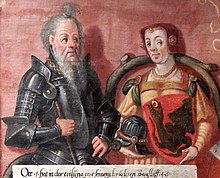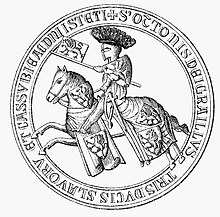Otto I. (Pomerania)

Otto I (* 1279 ; † December 30 or 31, 1344 ) was a Duke of Pomerania from the Greifenhaus . He ruled in Pomerania-Stettin from 1295 until his death , since 1320 together with his son Barnim III.
Life
Otto I was the youngest, later-born son of Duke Barnim I of Pomerania and his third wife Mechthild of Brandenburg. After the death of the father, the government in the Duchy of Pomerania initially led Otto's older half-brother Bogislaw IV. , Also for Otto and his older brother Barnim II. Mechthild had to protect her two sons against the half-brother. For the first time in 1294 Barnim II and Otto I carried out independent governmental acts.
After Barnim II died on May 28, 1295, possibly by force, Bogislaw IV and Otto I divided the Duchy of Pomerania into two parts of the country in the Treaty of Stettin on July 1, 1295 . Bogislaw IV received Pommern-Wolgast , the northern area on the Baltic Sea, in which the cities of Luebian law were located. Otto I. received Pomerania-Stettin , the southern area, inland and on the southern bank of the Stettiner Haff , in which the cities of Magdeburg were right . Despite this division of rule, the Duchy of Pomerania should continue to be owned by the dukes in full , and the homage to both dukes should take place together. The division agreed here lasted until 1478, when Duke Bogislaw X. reunited both parts of the country in his hands.
The two brothers initially took different political paths. While Bogislaw IV. Had armed conflicts with the Ascanian Margraves of Brandenburg in Western Pomerania , Otto I initially leaned against them. Otto I visited Margrave Albrecht III at Pentecost in 1298 . in Soldin and took part in his campaign in Mecklenburg in the same year . Otto I and Bogislaw IV later found an amicable policy, which was continued after Bogislaw IV's death in 1309 by his son Wartislaw IV .
In 1315 Margrave Waldemar von Brandenburg Otto I sold the land of Bernstein and later pledged Schivelbein and Dramburg to him . In 1319 there was a brief dispute between Otto I and his nephew Wartislaw IV, when Otto I had a dispute with several towns in his area and these were subject to the protection of Wartislaw IV.
The unexpectedly early death of Margrave Waldemar von Brandenburg in August 1319 brought the two dukes together again. Since Waldemar's heir was his cousin Heinrich II , who was only eleven years old , the prospect of acquiring parts of Brandenburg arose. Wartislaw IV succeeded in being recognized by the Neumark estates as Henry II's guardian. When Henry II died in adolescence in July 1320 and the Mark was ownerless, the opportunity seemed even more favorable; the Pomeranian dukes won a large part of the Uckermark .
In these times of armed conflict Otto I appointed his son Barnim III. to the co-regent. Otto's activity took a back seat to that of his son in the following events, such as the War of the Rügen Succession and the War of Pomerania-Brandenburg .
The Pomeranian dukes tried to have their imperial immediacy recognized . In 1338, at a Reichstag in Frankfurt am Main, King Ludwig IV released the dukes of Pomerania-Stettin, Otto I and his son Barnim III, from the suzerainty of Brandenburg and recognized their imperial immediacy. In return, Brandenburg, where King Ludwig's son Ludwig had been the Brandenburg Margrave since 1323 , received the Uckermark back, even if only for a large amount of money. At the same time, Pomerania-Stettin was to fall to Brandenburg, if the line of the Stettin dukes were to die out; In view of this, the cities of Pomerania-Stettin should already pay homage to Brandenburg. However, the cities refused to pay homage because, referring to the Treaty of Stettin of 1295, in the event of the Stettin line becoming extinct, they assumed a line of succession from the Wolgast line of the Greifenhaus. Ultimately, Otto I and his son, like Margrave Ludwig, waived this homage.
Duke Otto died on December 30 or 31, 1344. He was buried in the Marienkirche in Stettin . The government in Pomerania-Stettin was led by his son Barnim III. gone alone.
Marriages and offspring
Duke Otto first married Katharina in 1296, daughter of Count Gerhard II of Holstein and Ingeborg of Sweden. Katharina died after a few years; the marriage remained childless.
In his second marriage he married Elisabeth, the daughter of Count Nikolaus I von Schwerin. From the marriage emerged:
- Barnim III. (* before 1300; † 1368)
- Mechthild († 1331) ∞ Johann III. von Werle († 1352)
Elisabeth died in 1318 or 1319; she was buried in the Marienkirche in Stettin .
See also
literature
- Gottfried von Bülow : Otto I., Duke of Pomerania-Stettin . In: Allgemeine Deutsche Biographie (ADB). Volume 24, Duncker & Humblot, Leipzig 1887, pp. 719-722.
- Martin Wehrmann : History of Pomerania. Volume 1. 2nd edition. Verlag Friedrich Andreas Perthes, Gotha 1919. (Reprint: Augsburg 1992, ISBN 3-89350-112-6 )
- Martin Wehrmann : Genealogy of the Pomeranian ducal house. Publications of the regional historical research center for Pomerania, series 1, vol. 5. Leon Saunier, Stettin 1937, pp. 62–63.
Web links
| personal data | |
|---|---|
| SURNAME | Otto I. |
| BRIEF DESCRIPTION | Duke of Pomerania-Szczecin |
| DATE OF BIRTH | 1279 |
| DATE OF DEATH | December 30, 1344 or December 31, 1344 |
